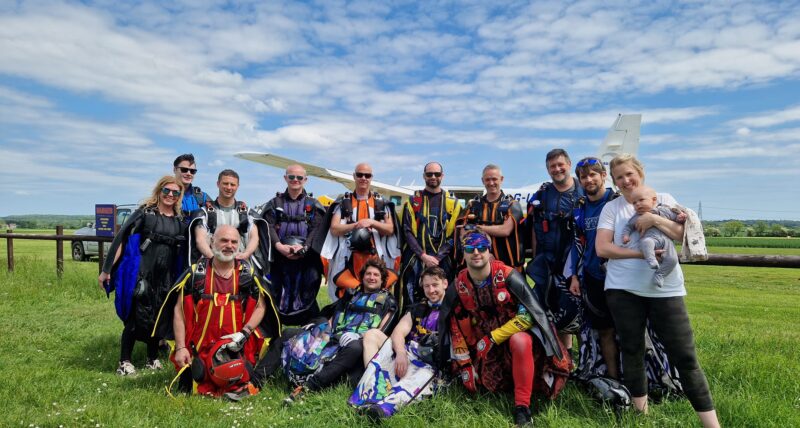After 21 years of voluntary service, Paul Applegate has retired as Chair of the Riggers’ subcommittee. Riggers is a part of STC, the British Skydiving Safety and Training committee, and both meet six times a year. STC is made up of every Chief Instructor in British Skydiving, while all Riggers who have held their rating for more than two years are eligible to vote at Riggers’ meetings. We spoke to Apples to find out a bit more about rigging.
Where did it all start for you, jumping-wise?
I was working as an apprentice in a garage and had a mate who lived in the village where I worked. I was only about 18 or 19 and we used to go out together all the time. One day I asked him what he was doing at the weekend and he told me that he was booked on a parachute course! He’d been driving past Compton Abbas and stopped to look into flying lessons, then found out that they also did parachuting and ended up signing up for that weekend. It was going to chuck it down with rain all weekend, but I went along with him anyway because he said there was a good bar. But that didn’t open until the evening, so I ended up bored and sitting in on his lectures with him while waiting for the bar to open. At the end of the day, I ended up talking to my mate’s Instructor in that bar, who suggested I should come back next weekend and do a jump myself. I asked what about my training and the Instructor said that I’d heard it all anyway so all I really needed was the medical! That night I slept under an old C9 round parachute at the airfield, then in the week my mate did a job for a doctor so I was able to get myself sorted with a medical. I did my first jump on April 28 1973. In fact, a few years ago at Hitch’s retirement party, he had his logbooks out on the table for nostalgia and I saw that his first sport jump was only the week before!
I joined 10 Para in 1977 and then later transferred into the REME. I was already well into skydiving, doing lots of demos and some work with Pete Allum at Slipstream Adventures. Then I got posted to Netheravon and that’s where I got all my ratings.

How and when did you get into rigging?
Well, I thought I might as well make it legal! Back then, everyone messed around with their kit. I already had a small business called Parafrocks, making jumpsuits, DZ bags and something we called monkey suits which were a bit like Symbi warmwear – well, there were no doors on most aircraft in those days. Jackie Smith taught me how to split my stabilisers for better Accuracy jumping, and I bought some tape from Woolworths then stitched it on to my Paracommander and hot knifed it in the kitchen.
I’ve always liked being able to mend stuff and having a challenge – as a mechanic, on my apprenticeship, in the REME and later at Matbro, as well as in rigging. I think my daughter’s first words were “daddy mend”! I started properly rigging under Joe Reddick at Netheravon, who was a hard taskmaster but taught me a lot, and Jim Walmsley. I qualified as a Rigger in 1984, then did my Advanced in 1987.
How and when did you end up as Chair of Riggers?
(Editor: Apples’ first answer was “No other bugger wanted to do it!”)
John Curtis badgered me to take the role on in 1997, then to join Council later that year (John had done both jobs himself as well). I already went to all the meetings. In fact, in 21 years as Chair of Riggers, I think I only missed two meetings and one of them was when my car broke down on the way to the BPA office!
Your phone is forever going off and it’s a real velvet-glove-andiron-fist malarkey. You’ve got to be fair and you end up with no friends in this job. People ring you up with a problem; they’ve found something wrong with a piece of kit and they want the packer’s ratings stripped off them. But then you get talking to understand the problem and you find out they haven’t spoken to the packer, they didn’t take photos, you have to slow down and be fair. It’s very different if a packer holds their hands up and admits they’ve made a mistake compared to someone who gets angry about it.
Dealing with packing and rigging incidents isn’t all that the Riggers’ Committee does, though. There’s a lot of approval of new kit, especially for Students Tandem, static line and AFF). It really helps to have been around the block and to know the manufacturers. It can speed things up and make things so much simpler when you can just ring up an old mate to ask a question.
There are also new developments that I’m proud to have been a part of. The Record of Inspection book was my brainchild, and I actually already used to make my own MOT-style card whenever I worked on someone’s kit. Now that bit of paper has been around for so long that most people don’t know anything different and it has been copied by other countries, but it came in originally because the Riggers’ Committee decided it was a good idea.
 What do you wish people knew about rigging?
What do you wish people knew about rigging?
Today, you’ll flightline someone, they’ll have put a piece of kit on their back and you’ll ask them what’s in it. They’ll be able to tell you all about the weird and wonderful kit they’ve got in the bottom and how small it is. Then you’ll ask them what’s up top and they don’t know.
Twists in brake lines wind me up. It’s really easy to take them out, and people need to learn to look after their own kit and not just throw it at a packer. All it takes is to remove the twists once a day and you won’t have a problem. Instead, people leave them in, then with modern microline they get burnt in and you end up needing to replace the entire LCLs (lower control lines). But first, the twisted brake lines will cause a mal and people will come in talking about the lineover they’ve just got off. Lineovers are practically impossible on modern squares! If you think you’ve had a lineover, you show me the damage to the top skin of your canopy – I bet you won’t find any. Now show me your video in slow-mo and I’ll show you that it wasn’t a lineover, it was twisted brake lines preventing a normal deployment and you could have prevented it by looking after your kit better. People say I can see through walls to spot people who haven’t taken their twists out, but it’s important to educate people as to why and not just have a go at them.
Long closing loops are another one; they should be murder-tight. Yes, it’s harder to close your container, but no, it’s not true that your pilot chute won’t be able to get the pin out – there’s a 90lb snatch force on a pilot chute. Okay, maybe less if your kill line is worn out, and then that’s another one people will change their kill line two-three times, but when did they last change their pilot chute?
What kind of jumping did you do and what stands out?
Filming, stunts, CRW, I was on the 8-way teams, demos, big-ways… a bit of everything, really. There wasn’t one particular highlight, it was all good. One story that stands out is the time when I had to close my own reserve in the open door of a DC-3. It was on run-in for Round 9 of the World Meet too…
He’s being modest because he didn’t mention any of the achievements for which he was awarded a Bronze Medal of the Royal Aero Club in 2016. Here is the citation that was written by the BPA:
“Paul Applegate is a stalwart of sport parachuting, a walking encyclopaedia of a sport that has been his passion for over 40 years. ‘Apples’, as he is affectionately known, has been a fun jumper, Instructor, discipline representative, national and international competitor and medallist. He has made more than 1,000 jumps as an Accelerated Free Fall Instructor. Today, he is a longstanding elected volunteer BPA Council member (since 1997) and has been Chair of the BPA Riggers’ Subcommittee for nearly 20 years.
“The time and effort that Apples has put into BPA affairs for the good of the sport is immeasurable. Now elevated to the status of a young-at-heart veteran, he is a source of wise counsel and advice to younger generations of skydivers whose careers in the sport he is always keen to support.
“Elected as a BPA Life Member in 1980 as a member of the exceptional British Canopy Formation Team of that period, which was awarded the Prince of Wales Cup by the Royal Aero Club, Apples has since been a constant source of stability and sagacity to so many skydivers over the years.
“Apples may truly be said to represent the bedrock of our sport, to which he continues to devote his life, to the benefit and appreciation of the whole skydiving community.”
 First published in the April 2019 issue of Skydive the Mag.
First published in the April 2019 issue of Skydive the Mag.





